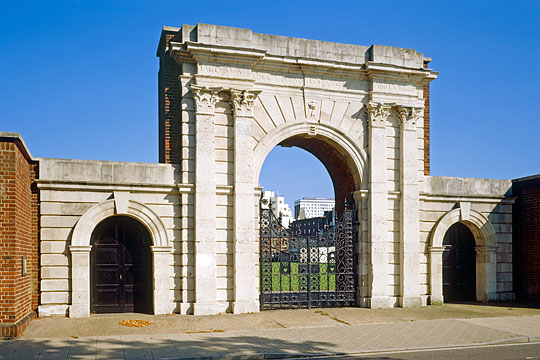History of King James’s Gate and Landport Gate
The strategic position of Portsmouth and its vital importance for the defence of the Channel coast led to the development of a protective circuit of defences around the town. Earthen ramparts constructed in the 14th century were strengthened by Henry VIII, and in 1665 Charles II instituted a major programme of reconstruction of the defences, and the building of the four gateways.

King James’s Gate
King James’s Gate was constructed in 1687. It was originally situated in Broad Street, in the south-west part of the town, close to the seaward defences, which still stand.
The gateway was dismantled in 1860 and was re-erected in its present position in the early 20th century.
Constructed of brick with stone facing, it has a tall arched opening with flanking pilasters and smaller arches, with 20th century panelled doors.
Landport Gate
The Landport Gate provided the main entrance to fortified Portsmouth and is the only gateway to survive on its original site.
The design of the gate has been attributed to Nicholas Hawksmoor, though it was constructed in 1760 after his death. It features a simple stone arch surmounted by a fine octagonal turret.
While built primarily for defensive purposes, these elegant town gates stand also as testimony to civic pride, and are rare survivors from this period.
Further Reading
Lilley, HT, Early Portsmouth Defences (Portsmouth, 1923)
Lloyd, DW, Buildings of Portsmouth and Environs: A Survey of the Dockyard, Defences, Homes, Churches, Commercial, Civic and Public Buildings (Portsmouth, 1974)


